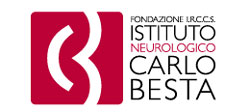 The Foundation of the Carlo Besta Neurological Institute, IRCCS
The Foundation of the Carlo Besta Neurological Institute, IRCCS
Nardo Nardocci
Via Celoria 11
20133 Milano, Italy
Phone: (+39) 02 2394 2210
Email: This email address is being protected from spambots. You need JavaScript enabled to view it.
Website: http://www.istituto-besta.com/
FINCB is an internationally recognized leading Centre in neuroscience; it diagnoses and treats neurological diseases in adults and children and carries out basic and clinical research in Neurology. It is composed of a Department of Clinical Neurology (250 beds), two Units of Child Neurology (40 beds), a Department of Neurosurgery (90 beds) and two Units of Neuroradiology and Radiotherapy. In addition a Department of Experimental Neurosciences includes the Unit of Molecular Neurogenetics, the Unit of Biochemistry and Genetics, the Unit of Neuromuscular Diseases, the Unit of Experimental Neurophysiology, and the Unit of Neuropathology. More than 25000 patients/ year are examined and treated at the Institute.
The Unit of Molecular Neurogenetics (Director Dr. Massimo Zeviani) is composed of 8 in-staff members including 2 neurologists, 3 biologists and 3 technicians, plus 13 full-time scientists. Research and advanced diagnostic activities are strictly combined to offer a service of excellence to patients, and make progress toward the elucidation of the causes of and mechanisms leading to mitochondrial diseases. Within this Unit, there is the Lab of Diagnostic of Movements Disorders directed by Dr. Barbara Garavaglia, devoted to the molecular genetics diagnosis of NBIA and other neurodegenerative diseases.
The Unit of Child Neurology (Director Dr. Nardo Nardocci) is composed of 26 beds for in-patients and a Day Hospital service, and has 8 in-staff child neurologists, 2 psychologists and 4 student fellows. The Unit includes different specialised units dedicated to the diagnosis and treatment of movement disorders, metabolic disorders, epilepsy, and immunomediated conditions.
Expertise
Dr. Valeria Tiranti has a long−standing expertise in mitochondrial disorders, including biochemical evaluation of the respiratory chain activities, molecular and cellular biology, and identification of pathogenetic mechanisms. She recently joined the NBIA field and has been studying PANK2−KO mice, received from Dr. Hayflick's laboratory, as well as patient’s derived fibroblasts in collaboration with Dr. Barbara Garavaglia. Dr. Barbara Garavaglia has a long experience in biochemical and molecular diagnosis of neurodegenerative and neurometabolic diseases. In 2002 she created the Movement Disorders Biobank with more than 2000 samples. The biobank is partner of the EuroBiobank and of the Telethon Network of Genetic Biobanks. Dr. Nardo Nardocci has been involved since many years in childhood movement disorders especially in the diagnosis and treatment of progressive, primary and eredo-degenerative dystonias. He has created a database of childhood movement disorder which includes clinical and videorecording documentation of more than 500 children with movement disorders.
